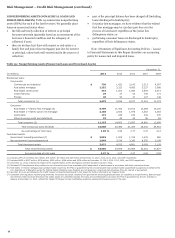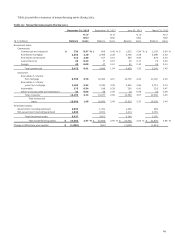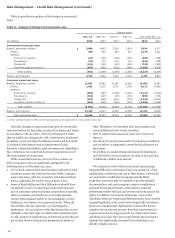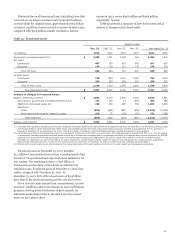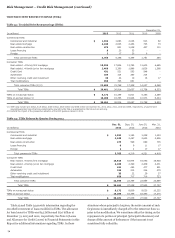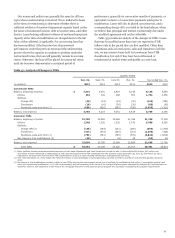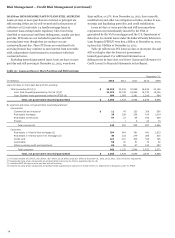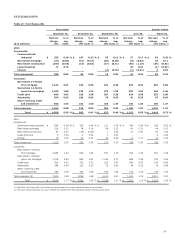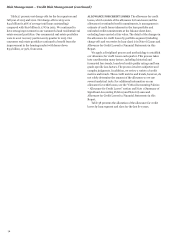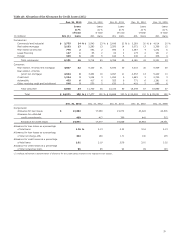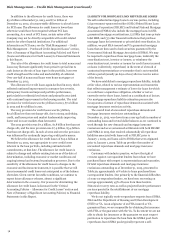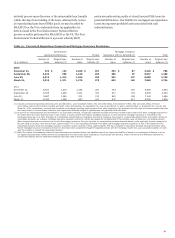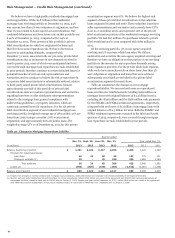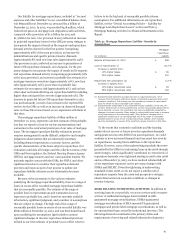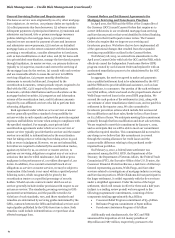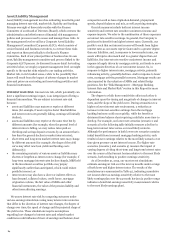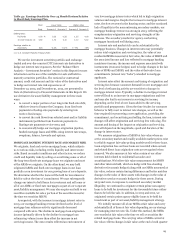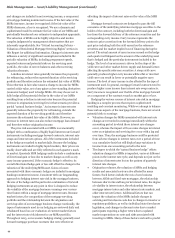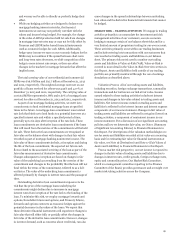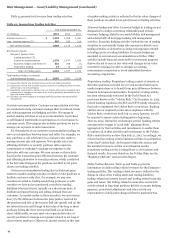Wells Fargo 2013 Annual Report Download - page 80
Download and view the complete annual report
Please find page 80 of the 2013 Wells Fargo annual report below. You can navigate through the pages in the report by either clicking on the pages listed below, or by using the keyword search tool below to find specific information within the annual report.Risk Management – Credit Risk Management (continued)
In addition to the allowance for credit losses, there was
$5.2 billion at December 31, 2013, and $7.0 billion at
December 31, 2012, of nonaccretable difference to absorb losses
for PCI loans. The allowance for credit losses is lower than
otherwise would have been required without PCI loan
accounting. As a result of PCI loans, certain ratios of the
Company may not be directly comparable with credit-related
metrics for other financial institutions. For additional
information on PCI loans, see the “Risk Management – Credit
Risk Management – Purchased Credit-Impaired Loans” section,
Note 1 (Summary of Significant Accounting Policies) and Note 6
(Loans and Allowance for Credit Losses) to Financial Statements
in this Report.
The ratio of the allowance for credit losses to total nonaccrual
loans may fluctuate significantly from period to period due to
such factors as the mix of loan types in the portfolio, borrower
credit strength and the value and marketability of collateral.
Over one-half of nonaccrual loans were home mortgages at
December 31, 2013.
The allowance for credit losses again declined in 2013, which
reflected continued improvement in consumer loss severity,
delinquency trends and improved portfolio performance,
particularly in residential real estate and primarily associated
with continued improvement in the housing market. The total
provision for credit losses was $2.3 billion in 2013, $7.2 billion
in 2012 and $7.9 billion in 2011.
The 2013 provision for credit losses was $2.3 billion,
$2.2 billion less than net charge-offs, due to strong underlying
credit, and home prices and market fundamentals improving
faster and in more markets than forecasted.
The 2012 provision was $7.2 billion, $1.8 billion less than net
charge-offs, and the 2011 provision was $7.9 billion, $3.4 billion
less than net charge-offs. In each of 2012 and 2011 the provision
was influenced by continually improving credit performance.
We believe the allowance for credit losses of $15.0 billion at
December 31, 2013, was appropriate to cover credit losses
inherent in the loan portfolio, including unfunded credit
commitments, at that date. The allowance for credit losses is
subject to change and reflects existing factors as of the date of
determination, including economic or market conditions and
ongoing internal and external examination processes. Due to the
sensitivity of the allowance for credit losses to changes in the
economic and business environment, it is possible that we will
incur incremental credit losses not anticipated as of the balance
sheet date. Given current favorable conditions, we continue to
expect future allowance releases, absent a significant
deterioration in the economy. Our process for determining the
allowance for credit losses is discussed in the “Critical
Accounting Policies – Allowance for Credit Losses” section and
Note 1 (Summary of Significant Accounting Policies) to Financial
Statements in this Report.
LIABILITY FOR MORTGAGE LOAN REPURCHASE LOSSES
We sell residential mortgage loans to various parties, including
(1) government-sponsored entities (GSEs) Federal Home Loan
Mortgage Corporation (FHLMC) and Federal National Mortgage
Association (FNMA) who include the mortgage loans in GSE-
guaranteed mortgage securitizations, (2) SPEs that issue private
label MBS, and (3) other financial institutions that purchase
mortgage loans for investment or private label securitization. In
addition, we pool FHA-insured and VA-guaranteed mortgage
loans that are then used to back securities guaranteed by the
Government National Mortgage Association (GNMA). We may
be required to repurchase these mortgage loans, indemnify the
securitization trust, investor or insurer, or reimburse the
securitization trust, investor or insurer for credit losses incurred
on loans (collectively, repurchase) in the event of a breach of
contractual representations or warranties that is not remedied
within a period (usually 90 days or less) after we receive notice
of the breach.
We have established a mortgage repurchase liability, initially
at fair value, related to various representations and warranties
that reflect management’s estimate of losses for loans for which
we could have a repurchase obligation, whether or not we
currently service those loans, based on a combination of factors.
Our mortgage repurchase liability estimation process also
incorporates a forecast of repurchase demands associated with
mortgage insurance rescission activity.
The overall level of unresolved repurchase demands and
mortgage insurance rescissions outstanding at
December 31, 2013, was down from a year ago both in number of
outstanding loans and in total dollar balances as we continued to
work through the new demands and mortgage insurance
rescissions and as we announced settlements with both FHLMC
and FNMA in 2013, that resolved substantially all repurchase
liabilities associated with loans sold to FHLMC prior to
January 1, 2009, and loans sold to FNMA that were originated
prior to January 1, 2009. Table 39 provides the number of
unresolved repurchase demands and mortgage insurance
rescissions.
Customary with industry practice, we have the right of
recourse against correspondent lenders from whom we have
purchased loans with respect to representations and warranties.
Of total repurchase demands and mortgage insurance
rescissions outstanding as of December 31, 2013, presented in
Table 39, approximately 10% relate to loans purchased from
correspondent lenders. Due primarily to the financial difficulties
of some correspondent lenders, we have been recovering on
average approximately 45% of losses from these lenders.
Historical recovery rates as well as projected lender performance
are incorporated in the establishment of our mortgage
repurchase liability.
We do not typically receive repurchase requests from GNMA,
FHA and the Department of Housing and Urban Development
(HUD) or VA. As an originator of an FHA-insured or VA-
guaranteed loan, we are responsible for obtaining the insurance
with FHA or the guarantee with the VA. To the extent we are not
able to obtain the insurance or the guarantee we must request
permission to repurchase the loan from the GNMA pool. Such
repurchases from GNMA pools typically represent a self-
78


